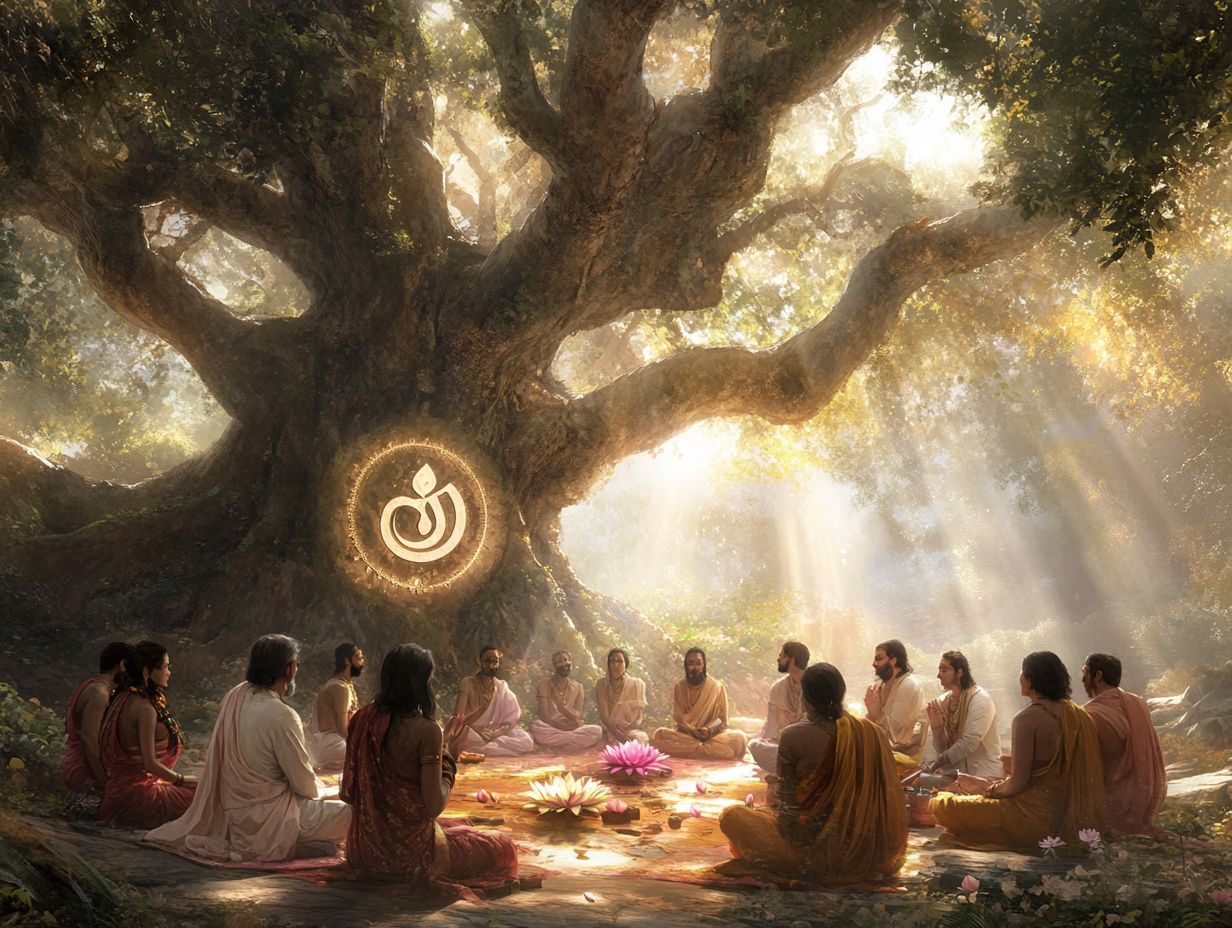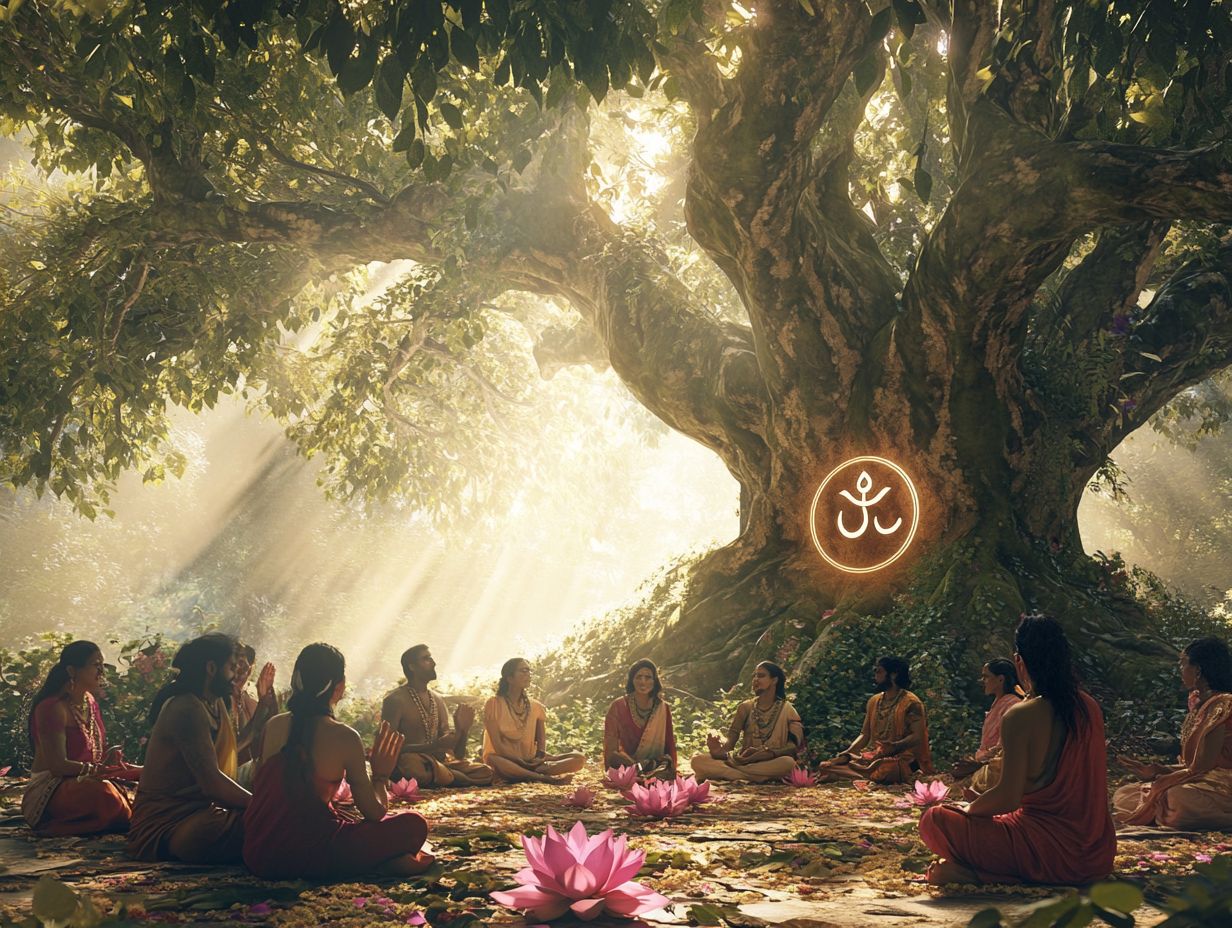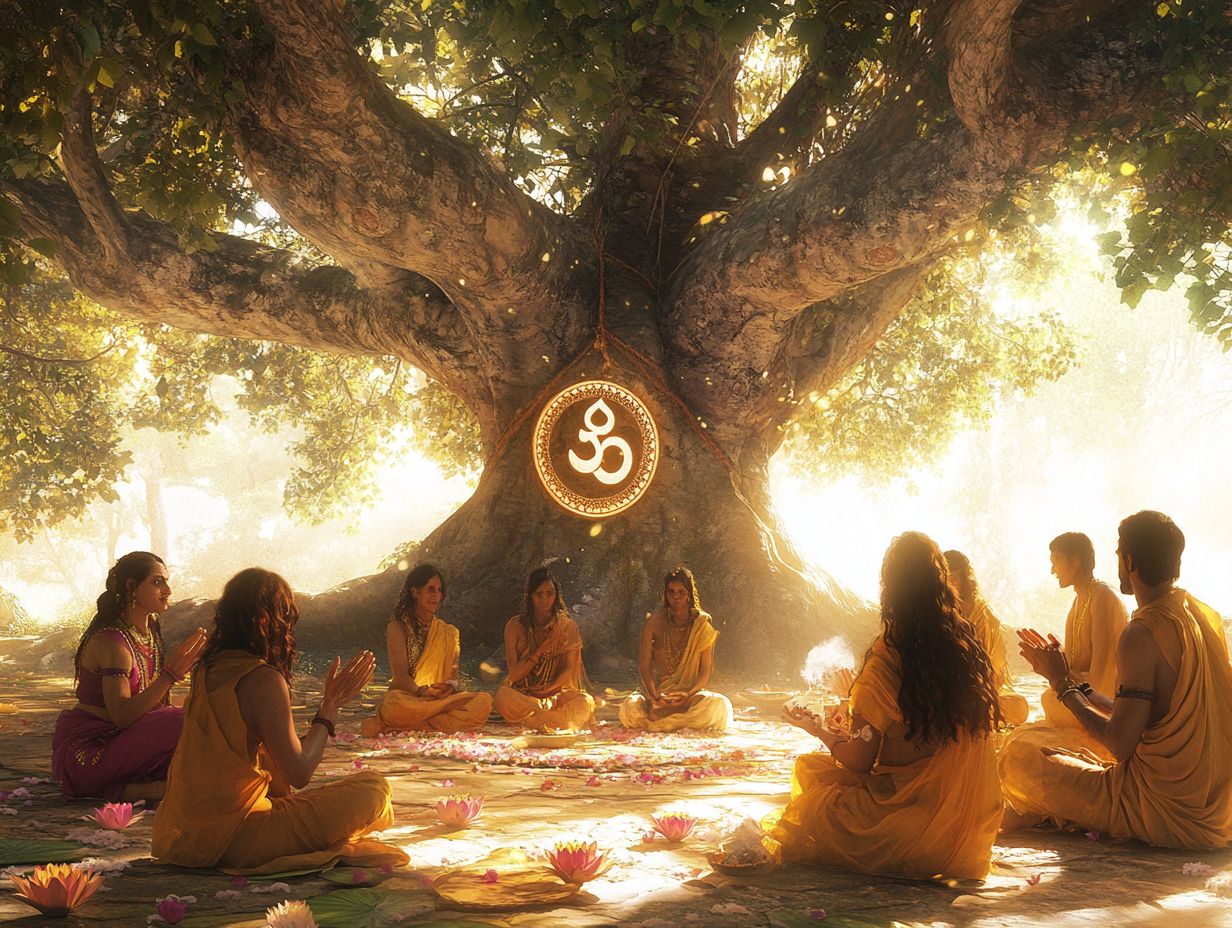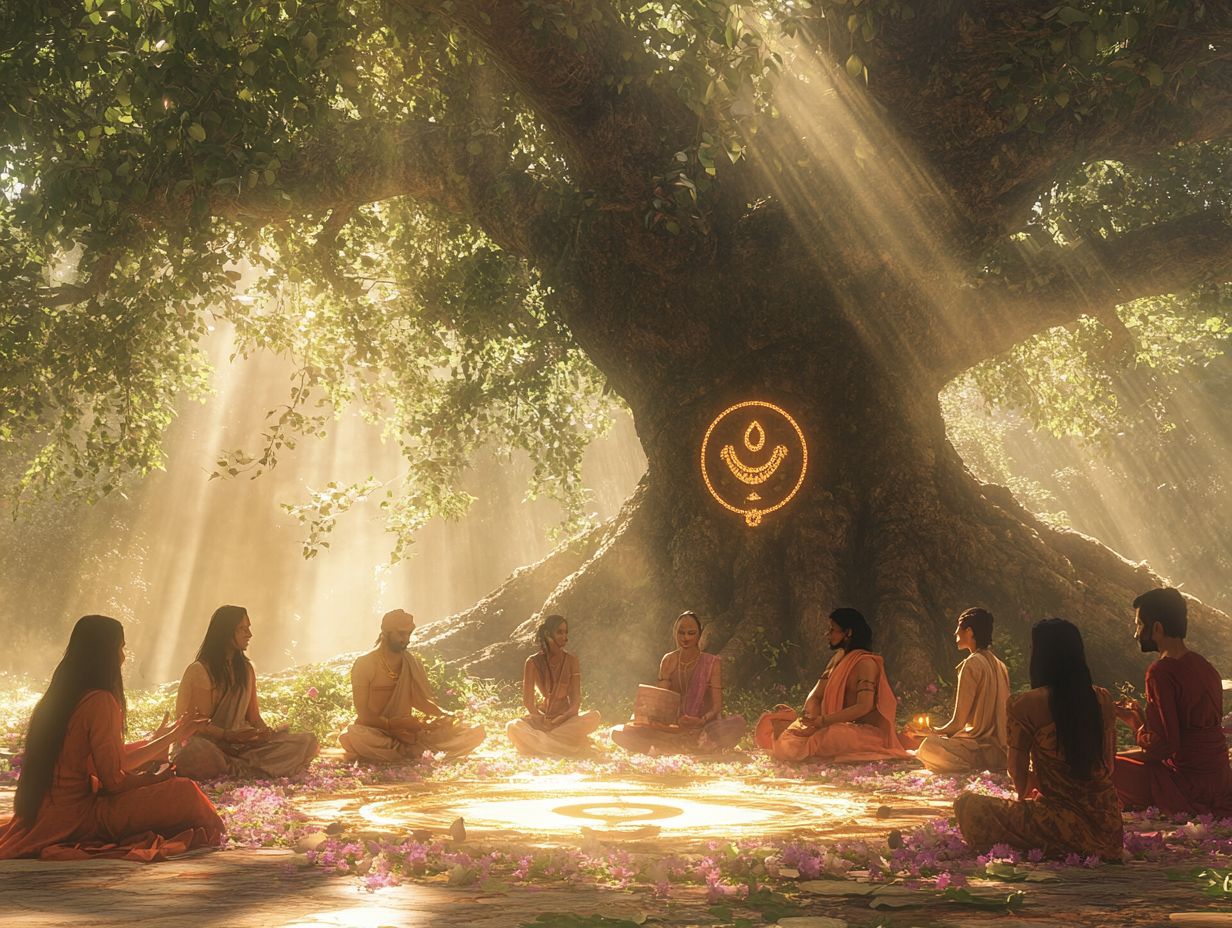What Are Hinduism Teachings?
Hinduism, recognized as one of the world’s oldest religions, presents a complex and intricate tapestry of beliefs, practices, and philosophies, including meditation, that guide millions on their spiritual journeys.
At the heart of this faith lie profound concepts such as reincarnation, karma, dharma, and moksha, accompanied by the veneration of a diverse pantheon of deities. The sacred texts, including the Vedas, Upanishads, and the Bhagavad Gita, offer deep insights into these foundational beliefs.
This article delves into the core teachings and principles of Hinduism, its revered texts, and the ethical values that shape the lives of its adherents. It invites readers to discover the essence of Hinduism and understand what makes it a distinctive spiritual path.
What Are the Core Beliefs of Hinduism?

Hinduism, recognized as one of the world s oldest religions, embodies a rich tapestry of beliefs and practices that revolve around the core concepts of Dharma, Karma, Moksha, and Reincarnation, which collectively form the bedrock of its philosophical and spiritual framework. The religion also places a significant emphasis on spirituality, devotion, and the practice of yoga as paths to liberation.
As a holistic tradition, it intricately weaves together various ethical values, rituals, and meditation techniques that guide its adherents on their journeys toward enlightenment and inner peace, while also embracing a multitude of perspectives on life, death, and the essence of reality.
With teachings deeply rooted in ancient scriptures such as the Vedas and Upanishads, Hinduism encourages individuals to embark on their spiritual journeys through community worship, meditation, devotion, and the veneration of deities, thereby cultivating a profound sense of unity amidst diversity.
1. Reincarnation and Karma
The concepts of Reincarnation and Karma lie at the heart of Hindu philosophy, where the soul, or Atman, is believed to traverse an intricate cycle of birth, death, and rebirth, referred to as Samsara. This journey is profoundly shaped by the actions undertaken in previous lives, guided by the principles of Dharma and Ahimsa (non-violence).
This cyclical process is not merely a matter of fate; it serves as a fundamental aspect of spiritual evolution, guiding individuals toward self-realization and, ultimately, liberation, known as Moksha. Within this framework, every thought, word, and action carries immense significance, either drawing the soul closer to enlightenment or further entrenching it in the cycle of rebirth. The practice of yoga paths, including Bhakti (devotion) and Karma Yoga (philosophy of action), is integral to navigating this process.
The Bhagavad Gita highlights the importance of righteous action, or dharma, indicating that virtuous deeds cultivate good Karma, leading to favorable rebirths, whereas negative actions can result in suffering. This aligns with the broader philosophy of Sankhya and the emphasis on righteous living.
For instance, the law of Karma illustrates that a compassionate act in one life may manifest as a more advantageous situation in a future existence. This intricate interplay of actions and their consequences nurtures a profound understanding of moral responsibility, intricately shaping the spiritual journeys of seekers as they aspire for ultimate union with the divine.
2. Dharma
Dharma, frequently interpreted as duty or righteousness, represents a pivotal concept in Hinduism, guiding individuals in their ethical conduct and moral values throughout life. It serves as an essential principle that shapes both personal and social responsibilities. Dharma also underscores the importance of family values and community service, which contribute to the collective good.
This multifaceted idea transcends simple obligation, embracing the notion of living in harmony with oneself, others, and the universe at large. Dharma not only directs personal behavior but also plays a significant role in the framework of social structures, delineating the various roles and responsibilities within families, communities, and society as a whole. The ancient traditions and cultural heritage of Hinduism further reinforce these values.
By faithfully adhering to their Dharma, individuals contribute to the collective good, nurturing community harmony and fostering spiritual development. The teachings found in sacred texts, such as the Bhagavad Gita and the Manusmriti, underscore the importance of aligning personal actions with one s Dharma, ultimately reinforcing societal cohesion and cultivating a profound sense of belonging and purpose. These actions also align with the principles of social justice and interfaith dialogue, promoting universal truth and harmony.
3. Worship of Many Gods and Goddesses
The worship of numerous gods and goddesses in Hinduism illustrates the religion’s remarkable diversity and complexity. Devotees partake in various rituals and offerings, known as Puja, to honor deities such as Brahma, Vishnu, Shiva, and Lakshmi, each representing distinct facets of the divine.
This multifaceted approach to devotion embodies a deeply ingrained belief in the interconnectedness of the universe and the personal relationships individuals forge with the divine. Vibrant festivals like Diwali and Holi serve not only as occasions for communal celebration but also as moments for introspection and renewal of faith.
The myriad forms of worship ranging from intricate ceremonies and family gatherings to solitary prayers enhance spiritual awareness while nurturing a sense of belonging among practitioners. Ultimately, these practices cultivate a profound connection to key deities, including Lakshmi, the goddess of wealth and prosperity, and Durga, the fierce protector who epitomizes strength and resilience.
4. The Concept of Brahman
In Hindu philosophy, Brahman is esteemed as the ultimate reality and the source of all existence, embodying a profound unity that transcends the duality of the material world and is intricately linked to the individual soul, or Atman. This notion of Brahman is pivotal to understanding the principles of transcendence, non-duality, and cosmic consciousness.
The inquiry into Brahman gives rise to significant philosophical questions concerning the nature of existence, truth, and the interconnectedness of all beings. Texts such as the Upanishads elucidate the concept of non-duality, highlighting how the illusion of separation poses a formidable challenge on the spiritual journey.
This perspective invites seekers to transcend the apparent diversity of life and recognize the fundamental essence that unites all. This recognition aligns with the principles of monism and dualism, which are explored within various philosophical schools of Hinduism.
Within this framework, the realization of Brahman can catalyze profound personal transformation, nurturing a deep sense of unity and an understanding that self-realization transcends the individual, representing a collective awakening to a shared reality. Such insights imply that the pursuit of spirituality may be less about acquiring something external and more about rediscovering the inherent connection with the cosmos and the divine reality.
What Are the Sacred Texts of Hinduism?
The sacred texts of Hinduism, comprising the Vedas, Upanishads, and Bhagavad Gita, stand as foundational scriptures that encapsulate the religion s profound teachings, philosophies, and spiritual wisdom. These texts are essential for understanding the ethical conduct and spiritual practices that constitute Hindu life.
These revered writings illuminate the path for adherents, guiding them on their journey toward enlightenment and self-realization.
1. The Vedas

The Vedas, esteemed as the most ancient scriptures of Hinduism, comprise an extensive assembly of hymns, rituals, and philosophical insights that underpin the essence of Hindu religious knowledge and practice.
These venerable texts are partitioned into four principal collections: the Rigveda, Samaveda, Yajurveda, and Atharvaveda. They are critical not only for grasping the spiritual architecture of Hinduism but also for their pivotal function in a myriad of rituals and ceremonies. The Vedas also offer insight into the cosmic order and the balance between the outer world and the inner self.
Each Veda caters to a specific purpose, ranging from chants designed to invoke divine blessings to comprehensive instructions for executing sacrificial rites. Vedic literature serves as the bedrock for numerous philosophies and schools of thought within Hindu traditions, highlighting the quest for truth, knowledge, and harmony in both individual and communal existence.
As practitioners delve into these scriptures, they discover a profound reservoir of guidance for their spiritual quests and rituals, ensuring that the teachings remain pertinent across generations.
2. The Upanishads
The Upanishads, often regarded as the philosophical apex of the Vedas, engage in profound explorations of reality, examining the intricate relationship between Brahman and Atman while highlighting the pursuit of self-knowledge through meditation.
These ancient texts illuminate the essence of spiritual practice, underscoring the significance of introspection and the transformative power of meditation. Through a rich tapestry of dialogues and parables, they adeptly guide seekers toward an understanding of the unity of existence, encouraging the cultivation of a deeper awareness of one’s inner self.
By looking into concepts such as non-duality and the interconnectedness of life, these writings emerge as timeless resources for those aiming to forge a profound connection with their spiritual essence. The teachings encapsulated in the Upanishads resonate not only within the realm of personal growth but also promote universal harmony, inviting practitioners to align their minds and hearts in the pursuit of truth. These texts advocate for mindfulness and the pursuit of spiritual awakening.
3. The Bhagavad Gita
The Bhagavad Gita unfolds a profound dialogue between Lord Krishna and Prince Arjuna, looking into essential concepts such as Dharma, duty, the caste system, and the spiritual path, thereby establishing itself as a crucial text for comprehending Hindu philosophy and ethics.
This timeless conversation acts as a guiding beacon, illuminating not only the responsibilities individuals bear in life but also the intricate complexities of moral dilemmas they encounter. The teachings of Hinduism encourage a deep reflection on personal values, urging the recognition that true fulfillment arises from aligning one s actions with a higher purpose.
It accentuates the significance of selfless action and the importance of devotion, elements that resonate profoundly in the journey of personal and spiritual development, often explored through practices such as yoga and meditation.
By integrating these teachings into daily life, individuals can cultivate inner peace and foster a sense of connection with the broader universe, ultimately enriching both personal growth and their understanding of their place within the grand tapestry of existence, often described in sacred scriptures like the Bhagavad Gita.
What Are the Main Deities in Hinduism?
The pantheon of Hindu deities features illustrious figures such as Brahma, Vishnu, and Shiva, each embodying distinct facets of the divine reality.
These deities play vital roles in the cosmic order and profoundly influence the spiritual lives of their devotees.
1. Brahma
Brahma, revered as the creator deity in Hinduism, holds a prestigious position for his pivotal role in cosmic creation and is often depicted with four faces, each symbolizing one of the four Vedas a crucial part of Hindu scriptures.
Each of these faces represents a distinct facet of knowledge, embodying the extensive wisdom encapsulated within the sacred texts. This significance extends beyond the mere formation of the universe; Brahma is also regarded as the origin of all beings, encompassing both the physical and spiritual dimensions of existence, aligning with the belief in the interconnectedness of the outer world and the inner self.
In the realm of worship, temples dedicated to Brahma are notably less common than those honoring other deities such as Vishnu or Shiva, underscoring the unique place he occupies in the devotion landscape. Devotees frequently invoke Brahma during significant rituals, recognizing his essential contribution to maintaining cosmic order through the act of creation.
His imagery and narratives serve as poignant reminders of the interconnectedness of all existence and the profound sanctity of knowledge.
2. Vishnu
Vishnu, revered as the preserver of the universe, is celebrated through his myriad avatars, including the illustrious figures of Rama and Krishna, who embody the principles of Dharma and provide profound guidance to their devotees through divine actions, as described in the Bhagavad Gita and other scriptures.
These celestial incarnations are pivotal in maintaining cosmic order, manifesting on Earth during tumultuous times to restore equilibrium between good and evil. The worship practices associated with Vishnu are often elaborate, encompassing offerings, chants, and devotional songs that express profound reverence and devotion.
Festivals such as Diwali and Janmashtami serve to illuminate his significance in the hearts of millions, showcasing the deep love and unwavering dedication of his followers. The teachings conveyed through his avatars inspire disciples to uphold righteousness, seamlessly integrating ideals of compassion and justice into their daily lives.
3. Shiva

Shiva, revered as the destroyer within the Hindu trinity, epitomizes both asceticism and the transformative essence of destruction, manifesting through a rich array of symbols, including the trident and the crescent moon. This inherent duality underscores his vital role in the cyclical processes of creation, preservation, and dissolution, illuminating the notion that destruction is not merely an endpoint, but rather a precursor to new beginnings.
Devotees acknowledge Shiva s significance through various worship practices, which include the chanting of sacred mantras, the ritualistic offering of water, and the meticulous crafting of representations of his iconic Nandi bull. His dance, known as the Tandava, serves as a profound emblem of the cosmic cycles of creation and destruction, mirroring the eternal rhythm of the universe.
Through these rituals, followers forge a deeper connection with Shiva’s multifaceted nature, embracing the paradox of a being who is simultaneously a formidable destroyer and a nurturing creator.
4. Devi
Devi, embodying the divine feminine principle in Hinduism, represents Shakti and is revered in myriad forms that symbolize power, compassion, and the nurturing dimensions of the cosmos, illustrating the dualism and monism present in Hindu beliefs.
Her veneration resides at the core of numerous festivals and rituals, each illustrating her multifaceted nature. From Durga Puja, where communities unite to celebrate her triumph over evil, to Navaratri, a nine-night festival dedicated to her various incarnations, the rituals encompass elaborate prayers, vibrant dance, and harmonious music, showcasing the community’s deep faith and devotion.
Each manifestation of Devi is honored in a distinctive manner, carrying both sacred and cultural significance that fosters a profound connection among devotees. Through offerings of flowers, sweets, and symbolic gestures, worshippers convey their reverence, earnestly seeking blessings for strength and prosperity in their lives, reflecting the principles of Bhakti and Puja.
This rich tradition encapsulates her essence within Hindu spirituality, elegantly bridging the divine with the ordinary.
What Are the Teachings and Principles of Hinduism on Morality and Ethics?
Hinduism imparts profound insights into morality and ethics, underscoring the importance of principles such as Ahimsa (non-violence), Dharma (righteousness), and Karma (action). These concepts, deeply rooted in ancient traditions and philosophical inquiry, serve as foundational values that guide the behavior of its adherents, fostering a deeply thoughtful and conscientious approach to life.
1. Ahimsa (Non-violence)
Ahimsa, the principle of non-violence, stands as a cornerstone of Hindu ethical thought, advocating for compassion toward all living beings and serving as a vital compass for personal conduct and social interactions, deeply influencing the community and interfaith dialogue.
This foundational concept shapes not only individual behavior but also has a profound impact on community well-being, fostering environments characterized by respect and harmony. By embracing Ahimsa, individuals are encouraged to reflect on their actions, promoting a climate of peaceful coexistence and facilitating resolution through dialogue and understanding, rather than through aggression, thus contributing to social justice and harmony.
When communities collectively adopt this principle, they nurture a culture of empathy and support, enhancing social bonds and fostering a sense of collective responsibility. As a hallmark of moral integrity, Ahimsa ultimately guides both individuals and their communities toward a holistic approach to living that honors human dignity and recognizes the interconnectedness of all life.
2. Dharma (Righteousness)
Dharma, emblematic of righteousness and duty, compels individuals to act with ethical integrity in alignment with their roles and responsibilities within society, thereby fostering harmony and social order within the broader tapestry of Hindu spirituality.
This ancient principle, deeply rooted in a multitude of philosophical and religious traditions, serves as a beacon for ethical conduct, enabling individuals to navigate both personal and professional spheres with a steadfast moral compass, promoting righteous living and ethical conduct.
By embracing Dharma, individuals cultivate a strong sense of duty that not only promotes their personal development but also contributes to the collective well-being of the community. In familial contexts, Dharma underscores the importance of obligations to family members, ensuring that relationships are both nurtured and respected, thus upholding family values and communal harmony.
On a broader societal scale, this ethical framework champions justice and equity, motivating individuals to undertake actions that benefit others and reinforcing the inherent interconnectedness of all beings.
Ultimately, the adoption of Dharma paves the way for a more compassionate society, where individuals recognize and fulfill their profound responsibilities toward one another.
3. Karma (Action)
Karma, understood as the law of action and consequence, underscores the principle that every action carries a corresponding effect, guiding individuals toward moral choices and ethical behavior in their daily lives, emphasizing the importance of personal accountability and moral values.
This profound concept instills a deep sense of personal accountability, allowing individuals to recognize that their thoughts, words, and deeds significantly influence not only their current circumstances but also their future outcomes.
By grasping the implications of Karma, one can fully appreciate the vital role of ethical decision-making in fostering both personal growth and social harmony. Adhering to principles derived from Hindu morality clearly illustrates that the choices made today resonate through time, impacting relationships and the wider community, and ultimately contributing to the pursuit of Moksha or liberation.
Therefore, embracing this awareness encourages more thoughtful and compassionate interactions with others, ultimately reinforcing the interconnectedness of all beings and fostering a sense of universal love and understanding.
4. Moksha (Liberation)

Moksha, or liberation, epitomizes the paramount objective of human existence within Hinduism, representing the soul’s emancipation from the relentless cycle of birth and rebirth, known as Samsara. It marks the attainment of enlightenment and the profound union with the divine, aligning with the ultimate spiritual goals of Hindu teachings.
This extraordinary state of liberation transcends mere cessation; it embodies a transformative journey that beckons individuals to seek deeper understanding and spiritual fulfillment. The path to Moksha may be traversed through a myriad of spiritual practices, including meditation, yoga, and the devotion of Bhakti each serving to foster a more intimate connection with the divine reality.
By nurturing virtues such as compassion and selflessness, practitioners can gradually disentangle themselves from worldly desires, aligning their actions with Dharma, or righteous living. Ultimately, the pursuit of Moksha inspires personal growth, inviting individuals to transcend physical limitations and recognize their intrinsic oneness with the universe, thereby leading to a state of everlasting peace that lies beyond the temporal realm. This journey often includes exploring the insights of Hindu scriptures such as the Vedas and Upanishads, and engaging with meditative and ascetic practices.
Frequently Asked Questions
What Are Hinduism Teachings?
Hinduism teachings are the principles, beliefs, and practices followed by followers of Hinduism, an ancient religion that originated in India. These teachings are encapsulated in texts like the Vedas, Upanishads, and the Bhagavad Gita, which guide practitioners in their spiritual and ethical conduct.
What are the core teachings of Hinduism?
The core teachings of Hinduism include the concepts of Dharma (duty), Karma (action), Samsara (reincarnation), and Moksha (liberation). These teachings aim to guide individuals towards leading a virtuous and purposeful life, encouraging moral values and ethical conduct. They emphasize devotion, meditation, and various yoga paths as means to achieve spiritual awakening and enlightenment.
Is Hinduism a monotheistic or polytheistic religion?
Hinduism is a diverse religion that allows for the belief in one supreme being, known as Brahman, while also acknowledging the existence of multiple deities and forms of divine energy. This dualism and monism coexist within Hinduism, reflecting its rich philosophical inquiry and interpretations across various sects and traditions.
Do Hinduism teachings promote non-violence?
Yes, Hinduism teachings promote Ahimsa, which is the principle of non-violence towards all living beings. This includes practicing compassion, kindness, and non-harm towards oneself and others. Ahimsa is deeply embedded in Hindu philosophy and ethical conduct, encouraging followers to live in harmony and balance with the outer world and inner self.
What role do rituals and ceremonies play in Hinduism teachings?
Rituals and ceremonies are an integral part of Hinduism teachings, as they are seen as a way to connect with the divine and attain spiritual growth. These practices vary among different sects and traditions of Hinduism. Common practices include Puja (worship), meditation techniques, prayer, and community service, each contributing to the holistic living and spiritual goals of the practitioners.
How do Hinduism teachings view the concept of time?
Hinduism teachings view time as cyclical rather than linear. This is reflected in the belief of reincarnation, where individuals are reborn multiple times until they achieve Moksha and break free from the cycle of birth and death (Samsara). This perspective influences Hindu views on life after death and the continuous journey toward spiritual awakening and self-realization.
